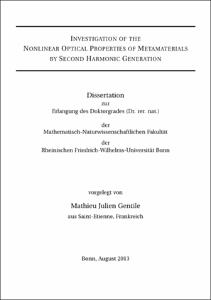Gentile, Mathieu Julien: Investigation of the Nonlinear Optical Properties of Metamaterials by Second Harmonic Generation. - Bonn, 2013. - Dissertation, Rheinische Friedrich-Wilhelms-Universität Bonn.
Online-Ausgabe in bonndoc: https://nbn-resolving.org/urn:nbn:de:hbz:5n-34032
Online-Ausgabe in bonndoc: https://nbn-resolving.org/urn:nbn:de:hbz:5n-34032
@phdthesis{handle:20.500.11811/5788,
urn: https://nbn-resolving.org/urn:nbn:de:hbz:5n-34032,
author = {{Mathieu Julien Gentile}},
title = {Investigation of the Nonlinear Optical Properties of Metamaterials by Second Harmonic Generation},
school = {Rheinische Friedrich-Wilhelms-Universität Bonn},
year = 2013,
month = nov,
note = {Metamaterials have attracted tremendous attention in the past decade because they allow researchers to engineer new optical properties by designing a new optical material. In particular, metamaterials are regarded as the key technology paving the way to an optical revolution, from medical applications to all-optical networks.
Metamaterials are sub-wavelength metallic nanostructures which owe their optical properties to the formation of a so-called plasmon, or collective electron oscillation. Each nanostructure can be regarded as a meta-atom forming an homogeneous optical material whose optical resonance features depend on three main parameters: The shape of the nanostructure, and the dielectric functions of both the material used and the surrounding environment.
Even though the nonlinear optical features are bound to play a central role for future applications, the underlying light conversion process has been unknown up to now. Moreover, hardly any of the plasmonic features found yet its way to an actual application.
In the present work, one makes use of the symmetry sensitivity and spectral information carried in the nonlinear process of second harmonic generation (SHG). Two types of investigations are carried out: First, gold nanostructures sharing symmetry feature variations are investigated to characterize the SHG in metamaterials. Second, simple gold nanowires are used to pattern the surface of an SHG-active host to investigate their application as an optical catalyst enhancing the SHG yield of the underlying crystal.
For the first time, broad SHG spectra are recorded from a variety of nanostructures sharing geometrical features. SHG is measured even from nanostructures described as centrosymmetric, or from tensor components expected to be symmetry forbidden. This work provides valuable insights into the potential role played by nanoscopic surface defects and irregularities resulting from the top-down electron-beam lithography (EBL) fabrication process.
The amplification model developed for the concept of an optical catalyst proves not to be sophisticated enough to fully explain the recorded SHG results. However, nanostructures fabricated on the surface of RMnO3 and Cr2O3 crystals display tweaked SHG features with respect to the known features from these nonlinear model systems. This is a clear indication of convolutions of the plasmonic process with a sample-specific response. Although the exact process could not be pinpointed, a certain dependence of the SHG yield on the environment of the nanowires has been highlighted and requires to take a closer look in future investigations.},
url = {https://hdl.handle.net/20.500.11811/5788}
}
urn: https://nbn-resolving.org/urn:nbn:de:hbz:5n-34032,
author = {{Mathieu Julien Gentile}},
title = {Investigation of the Nonlinear Optical Properties of Metamaterials by Second Harmonic Generation},
school = {Rheinische Friedrich-Wilhelms-Universität Bonn},
year = 2013,
month = nov,
note = {Metamaterials have attracted tremendous attention in the past decade because they allow researchers to engineer new optical properties by designing a new optical material. In particular, metamaterials are regarded as the key technology paving the way to an optical revolution, from medical applications to all-optical networks.
Metamaterials are sub-wavelength metallic nanostructures which owe their optical properties to the formation of a so-called plasmon, or collective electron oscillation. Each nanostructure can be regarded as a meta-atom forming an homogeneous optical material whose optical resonance features depend on three main parameters: The shape of the nanostructure, and the dielectric functions of both the material used and the surrounding environment.
Even though the nonlinear optical features are bound to play a central role for future applications, the underlying light conversion process has been unknown up to now. Moreover, hardly any of the plasmonic features found yet its way to an actual application.
In the present work, one makes use of the symmetry sensitivity and spectral information carried in the nonlinear process of second harmonic generation (SHG). Two types of investigations are carried out: First, gold nanostructures sharing symmetry feature variations are investigated to characterize the SHG in metamaterials. Second, simple gold nanowires are used to pattern the surface of an SHG-active host to investigate their application as an optical catalyst enhancing the SHG yield of the underlying crystal.
For the first time, broad SHG spectra are recorded from a variety of nanostructures sharing geometrical features. SHG is measured even from nanostructures described as centrosymmetric, or from tensor components expected to be symmetry forbidden. This work provides valuable insights into the potential role played by nanoscopic surface defects and irregularities resulting from the top-down electron-beam lithography (EBL) fabrication process.
The amplification model developed for the concept of an optical catalyst proves not to be sophisticated enough to fully explain the recorded SHG results. However, nanostructures fabricated on the surface of RMnO3 and Cr2O3 crystals display tweaked SHG features with respect to the known features from these nonlinear model systems. This is a clear indication of convolutions of the plasmonic process with a sample-specific response. Although the exact process could not be pinpointed, a certain dependence of the SHG yield on the environment of the nanowires has been highlighted and requires to take a closer look in future investigations.},
url = {https://hdl.handle.net/20.500.11811/5788}
}






